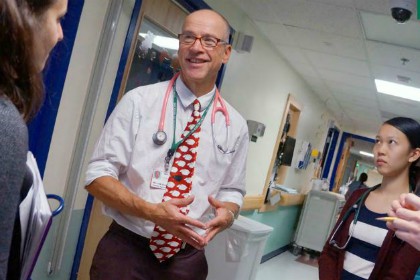
William Raszka, M.D., with medical students and residents at UVM Children’s Hospital
When third-year medical students at the Larner College of Medicine attend orientation for their pediatrics clerkship, they don’t sit and listen as an administrator explains what they can expect and how their grades are calculated.
Instead, they read a syllabus addressing those questions before they arrive. At that point, they take a quiz, followed by a comparison of their answers as a group. Then, the group gets into a conversation about clerkship objectives, the importance of personal and group reflection, and other topics like the tenets of family-centered care.
“It’s not just a quiz and we go on,” explains William Raszka, M.D., UVM pediatrics professor and director of the pediatrics clerkship. “We use it to lead to a broader discussion, because we want them to engage with the material.”
Orientation sets the stage for what’s to come, as the pediatrics clerkship incorporates active learning throughout. It is the first Larner College clerkship to feature an all-active regimen. By 2019, the college plans to shift the entire Vermont Integrated Curriculum to active learning methods. By incorporating small group discussion, flipped classroom exercises, simulation, and other teaching methods, not only do students apply the medical knowledge they’re learning, they also practice how to work in a team and effectively communicate.
The seven-week clerkship focuses on hands-on experience through rotations in pediatric primary care practices, children’s hospital units, critical care, and pediatric specialties. It also includes classroom sessions in areas such as fever and rashes, vaccines, abdominal complaints, and child abuse.
With active learning, those sessions start before the students get to the classroom. They receive reading materials, narrated PowerPoint presentations and videos that they review in advance, then come to class and take a “readiness” quiz. After the quiz, they discuss their answers, and an instructor makes sure to “close the gap,” as Raszka puts it.
“We want the students to be very comfortable saying, ‘I don’t understand. I don’t know why,’ ” he says. “That way, everyone has a level of knowledge and how to apply it.”
A child with a rash, for example, could have scarlet fever, toxic shock syndrome or Kawasaki disease. Students must not only explain their diagnosis but their reasons for choosing it. In the final step of active learning, students put the information they learned to real-life case studies.
The pediatrics clerkship includes five locations: UVM Medical Center; UVM Health Network affiliate sites in Vermont and New York; Western Connecticut Health Network in Norwalk, Conn.; St. Mary’s Hospital in West Palm Beach, Fla.; and Eastern Maine Medical Center in Bangor, Me.
Previously, all 17 students gathered—either in person or via Zoom video conference—at UVM’s Burlington campus for the group sessions. Now, the clerkship uses a “distributed model,” keeping students at their own sites for most active learning sessions.
Research shows that active learning improves student engagement, knowledge retention and, ultimately, test scores. Any student today can call up a description of meningitis symptoms on a smartphone, Raszka says. To identify meningitis as the cause of, say, a child’s altered mental status— rather than trauma, vasculitis or seizures—requires more than recitation of facts.
“We’re trying to foster, in a safe environment, application,” Raszka says. “It’s a way to apply the knowledge you have.”